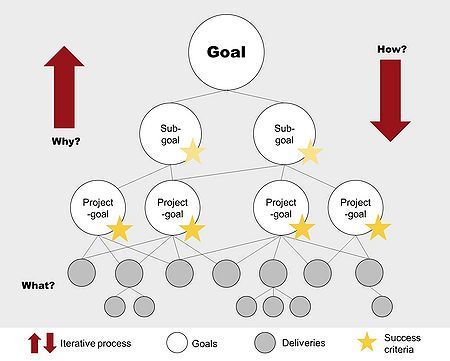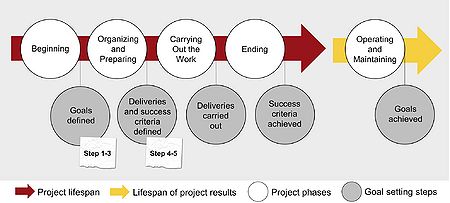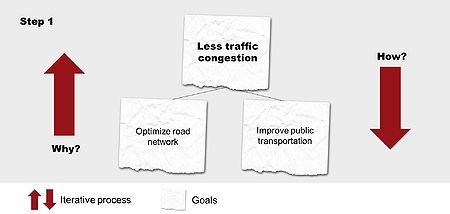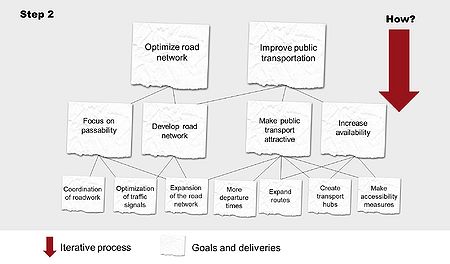Goal Hierarchy
| Line 35: | Line 35: | ||
== Application == | == Application == | ||
| − | [[File: | + | [[File: Goal_Hierarchy_project_lifespan.jpg |thumb|450px|right| Figure 2: The Goal Hierarchy elements in a project lifespan inspired by figure 3.4 (Attrup and Olsson) <ref> Attrup, M. L. and Olsson, J.R. , Power i projekter og portefølje, figure 3.4 page 96, DJØF Publishing (2008), ISBN: 978-87-574-1665-7 </ref> and figure 1-5 (PMBOK) <ref> Project Management Institute, Inc.. (2017). Guide to the Project Management Body of Knowledge (PMBOK® Guide) (6th Edition), figure 1-5 page 18. Project Management Institute, Inc. (PMI). Retrieved from https://app.knovel.com/hotlink/toc/id:kpGPMBKP02/guide-project-management/guide-project-management </ref> made by Emilie Torp.]] |
| Line 48: | Line 48: | ||
| − | [[File: Goal_Hierarchy_step1.jpg |thumb|450px|right| Figure 3: Step 1 of the Goal Hierarchy inspired by figure 3.8 (Attrup and Olsson) <ref> Attrup, M. L. and Olsson, J.R. , Power i projekter og portefølje, figure 3.8, DJØF Publishing (2008), ISBN: 978-87-574-1665-7 </ref> and figure 17 (Geraldi, Thesen, Oehmen and Stringl) <ref> Geraldi, J., Thuesen, C., Oehmen, J., & Stingl, V. (2017). How to DO Projects? A Nordic Flavour to Managing Projects, figure 17. Dansk Standard. DS Handbook Vol. 185 </ref> made by Emilie Torp.]] | + | [[File: Goal_Hierarchy_step1..jpg |thumb|450px|right| Figure 3: Step 1 of the Goal Hierarchy inspired by figure 3.8 (Attrup and Olsson) <ref> Attrup, M. L. and Olsson, J.R. , Power i projekter og portefølje, figure 3.8, DJØF Publishing (2008), ISBN: 978-87-574-1665-7 </ref> and figure 17 (Geraldi, Thesen, Oehmen and Stringl) <ref> Geraldi, J., Thuesen, C., Oehmen, J., & Stingl, V. (2017). How to DO Projects? A Nordic Flavour to Managing Projects, figure 17. Dansk Standard. DS Handbook Vol. 185 </ref> made by Emilie Torp.]] |
Revision as of 09:53, 19 February 2021
When managing projects, it is important that they have a specific direction to be successful. The direction of the project can be found by defining the purpose. If there is no purpose, there is no reason to do the project. When breaking down the purpose in smaller parts the scope can be defined. The scope should only include the processes that will help you ensuring that the project will be a success. [1] One way to help you defining the scope of your project is to apply the Goal Hierarchy.
The Goal Hierarchy is a goal-oriented iterative method that can be used to define the scope of your project. This by setting goals that can be brought up to date throughout the projects as knowledge expands. [2] The goals are broken down in different levels of details, by asking ‘why?’ and ‘how?’. You ask ‘why are we doing this?’ to make sure the goals make sense and ‘how are we doing this?’ to make the goals specific. Since the method is an iterative process you ask the questions again and again to improve the goals. The method consists of a hierarchy with a main goal on top followed by sub-goals, project-goals, deliveries, and success criteria. [3] It can be used for both project-, program- and portfolio management, however, the focus will be on using the method in a project management context.
This article will investigate the Goal Hierarchy and its purpose and how it can be applied to make your project more specific and goal-oriented. The application of the method will be followed by its limitations with a critical reflection of the method and its application. Hence you will be aware of what the method can and cannot do and when it will be beneficial to use after reading this article.
Contents |
Context
The Goal Hierarchy is a method that is developed for project management within the purpose perspective to find out what the scope of the project is. This, as mentioned previously, does not mean that the method cannot be applied to other types of management such as program- and portfolio management. Program management involves several projects that cannot be solved individually to achieve an objective. [4] In those cases, the Goal Hierarchy could be extended to include more projects with the same main goal on the top of the hierarchy. The same applies to portfolio management where one or more portfolios strive to achieve strategic objectives with selected programs or projects. [5] This type of management will also need an extended version of the method for it to be usable. This by customizing the method to the specific portfolio. Even though the method can be used for different management types, this article will focus on how to use the Goal Hierarchy as a project manager in order to simplify its use.
Description and Purpose
The Goal Hierarchy is a goal-oriented iterative method that can be used to help project managers defining the scope of their project. The method consists of goals that are broken down in different levels of details by asking the questions ‘why?’ and ‘how?’ again and again in order to improve the goals. The question ‘why?’ is about making sure that all the project goals are relevant. This forces the project manager to adjust the purpose as the project knowledge expands along the way. The other question ‘how?’ is about looking down in the hierarchy and investigating what to do to reach the goals by defining specific outputs. Outputs that details the plan by stating specifically what should be delivered to reach the goals. Specifically, the hierarchy consist of a main goal, sub-goals, project-goals, deliveries, and success criteria. The success criteria are added to be able to measure whether the project goals have been achieved. [8]
...
Application
Limitations
...
Annotated Bibliography
- Attrup, M. L. and Olsson, J.R. , Power i projekter og portefølje, DJØF Publishing (2008), ISBN: 978-87-574-1665-7
This book provides an insight into how to apply the Goal Hierarchy step by step. It is also possible to get concrete and easy to read examples of how the method is used, which makes the book very useful. In general, the book provides with lots of useful tools to manage projects in practice and it is therefore highly recommended.
- Project Management Institute, Inc.. (2017). Guide to the Project Management Body of Knowledge (PMBOK® Guide) (6th Edition). Project Management Institute, Inc. (PMI). Retrieved from https://app.knovel.com/hotlink/toc/id:kpGPMBKP02/guide-project-management/guide-project-management
This book is a standard that provides basic knowledge of project-, program-, and portfolio management, however, the focus is mainly on project management. To get an insight of how the Goal Hierarchy can be used in the differnet types of management, the standard is used to distinguish differences and understand what the objectives are within each form of management. The book is not the easiest to read, but if you are looking for answers to something specific, it is definitely useful.
- Geraldi, J., Thuesen, C., Oehmen, J., & Stingl, V. (2017). How to DO Projects? A Nordic Flavour to Managing Projects. Dansk Standard. DS Handbook Vol. 185
This book provides insight into the project management's four perspectives: purpose, people, complexity and uncertainty. The book shows an extended version of the Goal Hierarchy based on figure 38 from Olsson and Attrup, 2015, in chapter 6. The biggest difference is that the Goal Hierarchy is shown in one overall figure. The book can be recommended since it consists of useful theories and methods of project management.
References
- ↑ Project Management Institute, Inc.. (2017). Guide to the Project Management Body of Knowledge (PMBOK® Guide) (6th Edition) - 5. Project Scope Management, page 129. Project Management Institute, Inc. (PMI). Retrieved from https://app.knovel.com/hotlink/pdf/id:kt011DX4T1/guide-project-management/project-scope-management
- ↑ Attrup, M. L. and Olsson, J.R. , Power i projekter og portefølje, page 100, DJØF Publishing (2008), ISBN: 978-87-574-1665-7
- ↑ Geraldi, J., Thuesen, C., Oehmen, J., & Stingl, V. (2017). How to DO Projects? A Nordic Flavour to Managing Projects, page 113. Dansk Standard. DS Handbook Vol. 185
- ↑ The Standard for Program Management — fourth edition, page 10. (2017). ProQuest Ebook Central https://ebookcentral-proquest-com.proxy.findit.dtu.dk
- ↑ Project Management Institute, Inc.. (2017). Guide to the Project Management Body of Knowledge (PMBOK® Guide) (6th Edition) - 5. Project Scope Management, page 13. Project Management Institute, Inc. (PMI). Retrieved from https://app.knovel.com/hotlink/pdf/id:kt011DX4T1/guide-project-management/project-scope-management
- ↑ Attrup, M. L. and Olsson, J.R. , Power i projekter og portefølje, figure 3.8, DJØF Publishing (2008), ISBN: 978-87-574-1665-7
- ↑ Geraldi, J., Thuesen, C., Oehmen, J., & Stingl, V. (2017). How to DO Projects? A Nordic Flavour to Managing Projects, figure 17. Dansk Standard. DS Handbook Vol. 185
- ↑ Geraldi, J., Thuesen, C., Oehmen, J., & Stingl, V. (2017). How to DO Projects? A Nordic Flavour to Managing Projects, page 113. Dansk Standard. DS Handbook Vol. 185
- ↑ Attrup, M. L. and Olsson, J.R. , Power i projekter og portefølje, figure 3.4 page 96, DJØF Publishing (2008), ISBN: 978-87-574-1665-7
- ↑ Project Management Institute, Inc.. (2017). Guide to the Project Management Body of Knowledge (PMBOK® Guide) (6th Edition), figure 1-5 page 18. Project Management Institute, Inc. (PMI). Retrieved from https://app.knovel.com/hotlink/toc/id:kpGPMBKP02/guide-project-management/guide-project-management
- ↑ Attrup, M. L. and Olsson, J.R. , Power i projekter og portefølje, figure 3.8, DJØF Publishing (2008), ISBN: 978-87-574-1665-7
- ↑ Geraldi, J., Thuesen, C., Oehmen, J., & Stingl, V. (2017). How to DO Projects? A Nordic Flavour to Managing Projects, figure 17. Dansk Standard. DS Handbook Vol. 185
- ↑ Attrup, M. L. and Olsson, J.R. , Power i projekter og portefølje, figure 3.8, DJØF Publishing (2008), ISBN: 978-87-574-1665-7
- ↑ Geraldi, J., Thuesen, C., Oehmen, J., & Stingl, V. (2017). How to DO Projects? A Nordic Flavour to Managing Projects, figure 17. Dansk Standard. DS Handbook Vol. 185



